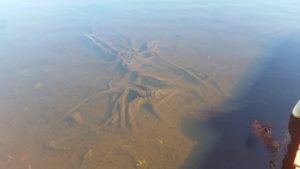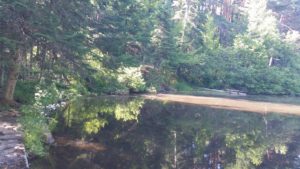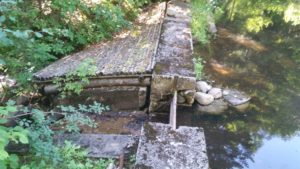I have a bunch more photos to put up about the final leg of our vacation (Ben’s graduation), but before I get to that I have a few other items, and a few other vacation photos, I want to post that really don’t go anywhere else.
Vacation Miscellany
Just a few photos of things around the cabin. Our place apparently was a camp once, having multiple primitive cabins, etc, and had been refurbished — and had the main house added — after years of downward fashionableness and possible abandonment; three cabins were still standing, one converted into a sort of detached den or game room, and the other two converted into separate sleeping quarters. Behind the cabins, as things were now arranged, was a small pond with a dam at one end. I’m not sure how important the pond had been in the past — it had the look of a kiddie fishing area — but now it was brown and scummy, and working its way back to being a meadow. (The lake was a lot better, but the muck at the bottom made for unpleasant swimming. Only Alex and I tried, and we only tried once.) There were other camp amenities, including a fire pit which we made use of on the chilly nights.
Shapes and Clusters
The clustering experiments were a success, but what I really want is to show the regions or neighborhoods where my cycling amenities are clustered. I’ve been trying several different ways to build a shape around a group of points:
- Convex Hull: this one is pretty nice, it’s the shape you’d get if a rubber band were stretched around the points. It’s also built into both QGIS and PostGIS. Unfortunately, if the point cluster has concavities the convex hull won’t show them — an L-shaped cluster would get a triangular region.
- Concave Hull: this one is also available in both QGIS and PostGIS, but I don’t trust it — I can’t find too much about how it really works, its very name doesn’t make all that much sense, and it requires parameters that are not as well documented as I’d like.
- Alpha Shape: the most promising of the bunch, defined pretty rigorously in “the literature,” and I like the l looks of the shapes it makes. Unfortunately, it doesn’t exist in either QGIS or PostGIS; it is available as a package in R, so I’ve spent some time this week getting R to run correctly after much neglect, then installing the “alphahull” package and trying it out. I managed to import my data and create alpha shapes; now I have to find how to convert and export the shapes back into my database.
There is one other method I just thought of, and pretty simple compared to these approaches: I could just make a heat map from the clustered amenities, then use a “contour line” function on the heat map raster. If the others don’t give satisfaction I may try this.
Around Here
Today was a brief respite from days of heavy, almost continuous rain — more is coming, starting tomorrow. I took the opportunity to attack the jungle that once was our back yard, managed to use up all the weed-whacker twine, and ran over a yellow jacket’s nest (no stings, but a fairly hasty retreat into the house for a while), and the yard looks much better if not quite 100% yet.
We’ve also had a Warm Showers guest: a young Brit named Arron who landed in New York and is cycling across the US. He’s early in his ride, not quite acclimated to cycling, and he’s getting a real baptism by fire, or at least by rain and hills and poor road choice, but he was a trooper. He stayed for two nights before heading for Coopersburg.



